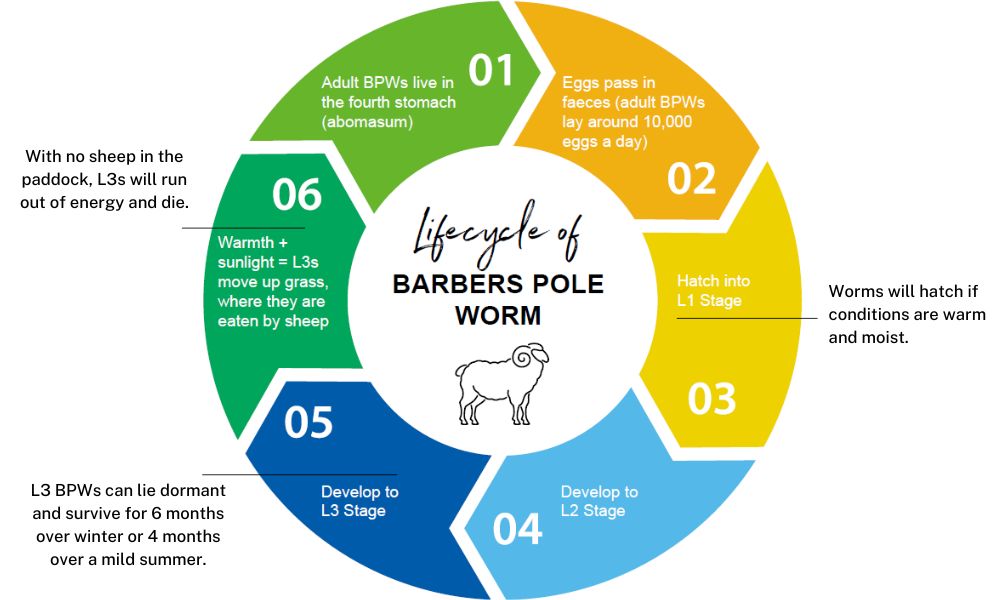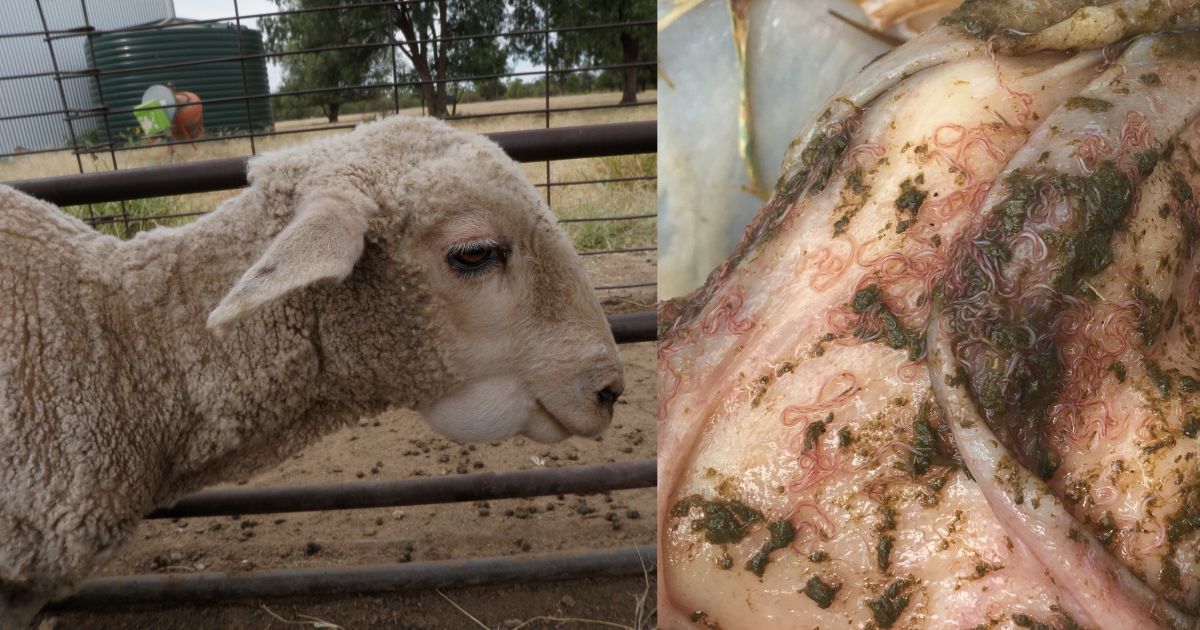Barber's Pole Worm
What are Barbers Pole Worms?
Barber’s pole worms are voracious blood feeders that suck blood from the lining of the stomach of sheep and goats, causing anaemia. The worms are about 2.5cm long and look like a barber shop’s pole with red and white stripes. These stripes are the worm's reproductive organs and digestive tract (that is full of blood) wrapped around each other.
When to watch for Barbers Pole Worms?
Rain and warm weather over spring provide ideal conditions for Barber's pole worm. It takes about 21 days for the worm to mature, so about 3-6 weeks after the rain event is when clinical signs in sheep are first observed.
Barbers' Pole Worm Lifecycle - Adult worms live and lay eggs in the fourth stomach. The female worm is a prolific egg producer, depositing up to 10,000 eggs per day onto pastures. Eggs pass in the faeces and hatch within a few days. Larvae emerge and, in favourable conditions, migrate on to pasture. Worm larvae are eaten by the sheep during grazing. In the sheep’s gut, larvae develop into adult worms in about three weeks.

Clinical signs of Barbers Pole Worm in sheep
- Affected sheep will have pale gums and conjunctiva (inside the eyelid).
- They may develop bottle jaws
- Will lack stamina, for example want to lie down when being mustered or moved
- Often the sheep go from looking fat and healthy to dead very quickly with few symptoms.
Sheep showing clinical signs of barber's pole worm infestation will often lag behind the mob when mustering and collapse.
On post mortem of a freshly dead sheep, you will see the Barber's pole worms in the fourth stomach (or abomasum) – this is the stomach with the shiny smooth internal lining. The Barber's pole worms can be seen with the naked eye. They are about an inch long and about as thick as a human hair.
The sheep carcass will be pale. The muscles won’t be dark red but will instead be pale pink or white and the sheep’s blood will be watery. If the sheep has been dead for longer than about an hour, the worms in the fourth stomach will be digested and you won’t see them – all you will see is a dark brown/red liquid in this stomach; this is a tell-tale sign that worms were present when the sheep was alive.

Sheep infected with Barber's pole worm, and post-mortem BPWs in the abdomen.
How to manage and prevent Barbers Pole Worm
Integrated control programs, including paddock management, monitoring and quarantine drenching, can help reduce the negative impacts of BPW.
Producers should start doing testing for worms in Spring (Sep/Oct) and continue over summer before drenching.
Prevention of high worm burdens is extremely important to reduce our reliance on drenches and to reduce the likelihood of drench resistance. There are a variety of methods, and the combination of these will vary from property to property, year to year.
- Grazing management – creating low worm risk pastures for high-risk classes of sheep (generally lambing ewes and weaners) by keeping stock out of selected paddocks
- Breeding sheep to be more resistant or resilient to worms
- Use of barbervax vaccine (for barber’s pole worm only)
- Use of Bioworma®
- Ensuring optimum nutrition
- Performing regular worm egg counts – these tests give an idea of whether a mob has a worm problem before they start showing signs of disease. They can be done through the NSW state veterinary lab with a kit available from our offices, or through private providers.
How to treat Barbers Pole Worms
Please do not reach straight for the drench gun. Do a worm test first. Worm test kits are available from your local LLS office. The worm tests come with 10 vials, gloves, submission form, and easy to use instructions for how to test to collect faeces to test for worms.
There are plenty of drench resistant strains of barber's pole worm so producers need to get sound advice on worm management. Call your District Vet and arrange a Drench Resistance Trial on your farm. A good drench program and pasture management is essential to minimise losses caused by worms.
Treating a mob affected by worms involves giving a medication (drench) to kill the worms. As a general rule, drenching with two or more active ingredients (drench classes) is better than using a single active drench. Treating a mob this way is important for animal welfare – without drenching, more sheep will become ill and die.
With all drenches, leave sheep in the yards for 24 hours after drenching, with access to water. This will help them to empty out the remaining worm eggs in their digestive tracts before being put out to clean pasture. A clean paddock means one that has been spelled (ie not grazed) for six months over winter, four months over a mild summer, or one month over a hot dry summer
Download our fact sheet PDF, 540.5 KB for more information.
Barbers Pole Worm in goats
While goats and sheep share the same internal parasites, such as Barbers Pole Worm and Black Scour Worm, they need to be considered differently in some respects when it comes to managing their worm burdens.
Unlike sheep, goats evolved over many years to deal with worms by using grazing behaviour to stay away from worms – this is why they’re happy browsing from trees, eating from the tops of large grass tufts and sampling the washing from the clothesline. As a result of this evolutionary change, goats developed large and highly efficient livers to deal with the toxins in the trees and other browse plants.
These important differences in goats mean that if you fence them in and ask them to eat within 10cm of ground level (where most of the worm larvae live) they are incredibly susceptible to picking up worms; and that many of the drenches that are used in sheep cannot just be used in goats at sheep dose rates as their liver metabolises them very differently.
It is important to accurately estimate goat weight so that goats can be accurately dosed with drenches and other medications. A set of scales are a good investment, or if you’ve got a smaller flock, girth bands for goats can be helpful to assess body weight.
Delayed grazing is sometimes used with smaller goat producers. Goats are housed in the evening and let out mid-morning when the morning moisture has travelled down the pasture sward, along with the worm larvae, and hence decreasing the larvae exposure to the goat.
Adapted from content by district vets Jill Kelly and Belinda Edmonstone.